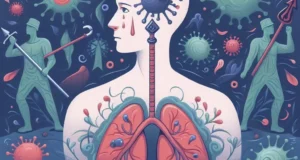If the spark of HIV was struck in the depths of the jungle, then the fire was fueled by the cities. Welcome to the Urbanization Spillover Loop—a metaphorical engine room where the virus, once hidden in shadows, found light, movement, and momentum. And as we continue to search for answers to the enduring question—AIDS, where did it come from?—we must look not just to forests and primates, but to the restless streets of growing African cities.

The early 20th century witnessed more than colonial conquest; it marked the birth of rapid urban development across central Africa. Cities like Kinshasa (then Léopoldville) weren’t just growing—they were exploding. Railroads, trade hubs, mining towns, and administrative posts attracted thousands. Men moved to find work. Women followed—or were left behind. Families were broken. New, unstable communities emerged. In these cracks of modernity, the virus found its rhythm.
The Urbanization Spillover Loop is not a single event but a cyclical system—a feedback loop born of migration, medical gaps, sexual networks, and lack of infrastructure. HIV, after making its silent zoonotic leap from chimpanzee to human, was likely confined to small, isolated cases. But cities changed everything.
Imagine HIV as a hidden ember flickering in a remote village. Now place that ember in a crowded slum with poor sanitation, inadequate healthcare, and social disconnection. Add to that mix mass movement of people—miners, sex workers, laborers, and soldiers—and suddenly the ember becomes wildfire.
Public health systems were virtually nonexistent. Clinics reused needles. Blood transfusions were unregulated. Urban centers became both the hub and the highway for the virus. In the jungle, HIV whispered. In the cities, it found a microphone.
This loop operated like a viral carousel: people entered cities, contracted or passed on HIV unknowingly, and returned to their home villages—where the cycle would begin again. The virus moved in waves, not lines. And each cycle made it smarter, stronger, and more deeply embedded in the human population.

So when we ask, “AIDS, where did it come from?”, we must not only picture a hunter in a forest—we must see the ripple that moved from that hunter through a sprawling cityscape. The virus didn’t spread alone. It rode on the back of urban chaos, fueled by poverty, population density, and a colonial legacy that left no time to build medical safeguards.
In Kinshasa, evidence now suggests that HIV Group M, the strain that would become the global pandemic, began to circulate widely as early as the 1920s or 1930s. By the 1960s, it had spread to Haiti, and then to the United States by the late 1970s. But its true accelerator—its original launchpad—was this Urbanization Spillover Loop, a vortex of human movement and modern vulnerability.
This loop wasn’t evil. It wasn’t intentional. It was simply a byproduct of transformation—a side effect of rapid change with no time for safety nets. The virus did not create the loop; it merely found it already turning, and stepped inside.
In the grand narrative of AIDS origin, the Urbanization Spillover Loop deserves its chapter. It reveals that HIV’s journey wasn’t just a medical event—it was a social one. It wasn’t just about blood; it was about borders, cities, and the unplanned consequences of modern life.
So the next time the question arises—“AIDS, where did it come from?”—we must look beyond science alone. We must see the unseen machinery of urbanization, how it created a loop that HIV used not to escape, but to evolve. A loop still turning in places where disease can thrive in the gaps between progress and preparedness.




